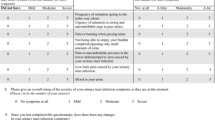Abstract
Electromotive drug administration (EMDA) involves the active transport of ionized drugs such as lidocaine by the application of an electric current. Twenty-one female subjects with interstitial cystitis were treated with EMDA of lidocaine and dexamethasone, followed by cystodistension. The procedure was convenient and well tolerated, with hospital attendance for 1 hour. Bladder anesthesia was excellent, with cystodistension from a discomfort level of 200 ml to a mean volume of 600 ml. Eighty-five percent had a good response (reduction in frequency and in pain score by 3 or more) at 2 weeks, with 63% still responding at 2 months. An excellent response (pain score of 0) was present in 25% of patients reviewed at 6 months. These results are comparable to the response following cystodistension under general anesthesia. There is a need for a randomized blinded comparison of lidocaine with and without EMDA. If proven to be of pharmacological efficacy, EMDA would have many applications in facilitating procedures previously requiring general anesthesia.
Similar content being viewed by others
References
Hanno PM, Buehler J, Wein AJ. Use of amitriptyline in the treatment of interstitial cystitis.J Urol 1989;141:846–848
Parsons CL. The therapeutic role of sulfated polysaccharides in the urinary bladder.Urol Clin North Am 1994;21:93–99
Hanno PM, Wein AJ. Interstitial cystitis Part II.Urol Clin North Am 1994;21:136–141
Seshadri P, Emerson L, Morales A. Cimetidine in the treatment of interstitial cystitis.Urology 1994;44:614–616
Messing EM. Interstitial cystitis and related syndromes. In Walsh PC, Retik AB, Stamey TA, Vaughan ED Jr (eds) Campbell’s Urology, 6th edn. Philadelphia: WB Saunders, 1992;982–1005
Sant GR, LaRock DR. Standard intravesical therapies for interstitial cystitis.Urol Clin North Am 1994;21:73–83
Perez-Marrero R, Emerson LE, Feltis JT. A controlled study of dimethyl sulfoxide in interstitial cystitis.J Urol 1988;140:36–39
Messing EM, Stamey TA. Interstitial cystitis, early diagnosis, pathology, and treatment.Urology 1978;12:381–392
Morales A, Emerson L, Nicel JC et al. Intravesical hyaluronic acid in the treatment of interstitial cystitis.J Urol 1996;156:45–48
Peters K, Gonzales J, Steinhart B et al. The efficacy of Tice Bacillus Calmette-Guerin in the treatment of interstitial cystitis: a double blind, prospective, placebo controlled trial.J Urol 1996;155:441A
Fall M, Lindstrom S. Transcutaneous electrical nerve stimulation in classic and nonulcer interstitial cystitis.Urol Clin North Am 1994;21:131–139
Irwin PP, Galloway NTM. Surgical management of interstitial cystitis.Urol Clin North Am 1994;21:145–151
Russo J, Lipman AG, Comstock TJ et al. Lidocaine anaesthesia: comparison of iontophoresis, injection and swabbing.Am J Hosp Pharm 1980;22:152–155
Stephen RL, Miotti D, Bettaglio R et al. Electromotive administration of a new morphine formulation:morphine citrate.Artif Org 1994;18:461–465
Hicks RM, Ketterer B, Warren RC. The ultrastructure and chemistry of the luminal plasma membrane of the mammalian urinary bladder: a structure with low permeability to water and ions.Phil Trans Roy Soc Lond B 1974;268:23–38
Thompson AC, Christmas TJ. Interstitial cystitis — an update.Br J Urol 1996;78:813–820
Turner JA, Deyo RA, Loeser JD et al. The importance of placebo effects in pain treatment and research.JAMA 1994;271:1609–1614
Parsons CL. Interstitial cystitis. In Kursh ED, McGuire EJ (eds) Female urology. Philadelphia: JB Lippincott, 1994;421–438
Dasgupta P, Fowler CJ, Hoverd P et al. Does electromotive drug administration (EMDA) with lignocaine before intravesical capsaicin confer benefit? Presented at the American Urological Association Meeting, New Orleans, April 1997
Lazzeri M, Beneforti G, Benaim CA et al. Intravesical capsaicin for treatment of severe bladder pain: a randomized placebo controlled study.J Urol 1996;156:947–952
Author information
Authors and Affiliations
Additional information
EDITORIAL COMMENT: Electromotive drug administration is a new therapy being evaluated by these researchers for interstitial cystitis. Traditional drugs and hydrodistention are used with the addition of this new modiality. Randomized controlled trials are necessary to see if the initially good results can be confirmed.
Rights and permissions
About this article
Cite this article
Rosamilia, A., Dwyer, P.L. & Gibson, J. Electromotive drug administration of lidocaine and dexamethasone followed by cystodistension in women with interstitial cystitis. Int Urogynecol J 8, 142–145 (1997). https://doi.org/10.1007/BF02764846
Issue Date:
DOI: https://doi.org/10.1007/BF02764846




